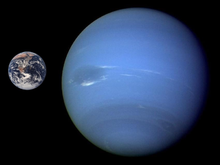Earth mass
Appearance

Earth mass (M⊕) is the unit of mass equal to that of the Earth. 1 M⊕ = 5.97219 × 1024 kg.[1] Earth mass is often used to describe masses of rocky terrestrial planets.
The three other terrestrial planets of the Solar System, Mercury, Venus, and Mars, have masses of 0.055, 0.815, and 0.107 Earth masses respectively.
One Earth mass can be converted to related units:
- 81.3 Lunar mass (ML)
- 0.00315 Jupiter mass (MJ) (Jupiter has 317.83 Earth masses)[2]
- 0.0105 Saturn mass (Saturn has 95.16 Earth masses)[3]
- 0.0583 Neptune mass (Neptune has 17.147 Earth masses)[4]
- 0.000 003 003 Solar mass (M☉) (The Sun has 332946 Earth masses)
See also
References
- ^ "Solar System Exploration: Earth: Facts & Figures". NASA. 13 Dec 2012. Retrieved 2012-01-22.
- ^ Williams, Dr. David R. (02 November 2007). "Jupiter Fact Sheet". NASA. Retrieved 2009-07-16.
{{cite web}}: Check date values in:|date=(help) - ^ "Solar System Exploration: Saturn: Facts & Figures". NASA. 28 Jul 2009. Retrieved 2009-09-20.
- ^ "Solar System Exploration: Neptune: Facts & Figures". NASA. 5 Jan 2009. Retrieved 2009-09-20.
